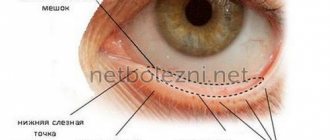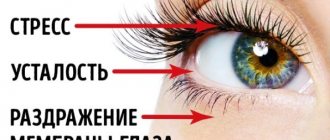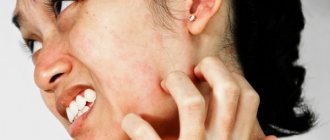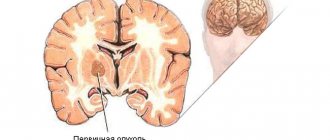Counterparts may not notice such a movement of the eyelid, but for the one to whom this happens, the sensations are not very pleasant. However, they are also harmless. You can’t ignore a tic at all: it notifies you of any problems in the body, problems of the nervous system, overwork, or mental disorders.
Why does the eye twitch
Movements of the eyelid muscles that occur against a person’s will for some time are called nervous tics (hyperkinesis). You can suppress it, but not always and not for long. There are many reasons for this phenomenon in adults:
- Prolonged stress, emotional shock, strong anxiety, worries, that is, all situations associated with muscle tension. Myocamia (involuntary, spontaneous contraction of the muscles of the lower and, less commonly, upper eyelid) is provoked by a false signal sent to the brain by excited neurons.
- Lack of sleep. But if previously it was believed that the norm for an adult is 8–9 hours, now experts say that this indicator is individual for each person. In any case, if the body does not have enough sleep for proper rest, then it makes itself felt, including tics.
- Avitaminosis is a lack of vitamins.
- Electrolyte imbalance due to a lack of calcium, magnesium, and other microelements in the body is the result of poor nutrition.
- Eye strain from prolonged use of a computer and other new-fangled gadgets, excessive viewing of television programs, reading in poor lighting.
- Side effect of certain medications. Therefore, it is recommended that before taking any drug, you carefully study the attached instructions.
- Excessive passion for drinks containing caffeine - tea, coffee, some types of soda.
- Eye injury, foreign body or irritating substances entering it.
- Bad habits that cause overstimulation of the nervous system - drinking alcohol, smoking.
- Dry mucous membranes, so-called “dry eye”. The cornea is not properly moistened with tear fluid, and the neurons send the brain a false impulse.
- Organic damage to the central nervous system, leading to increased neuro-reflex excitability and decreased muscle tone and reflexes.
- Exacerbation of eye diseases - blepharitis, conjunctivitis, etc.
- Weakened immunity after surgery, influenza, acute respiratory infections, acute respiratory viral infections and other infectious diseases.
- Sore throat – chronic tonsillitis. Frequent swallowing of saliva due to illness causes spasm of the eyelid muscle.
- Involuntary movement of the eyeballs - nystagmus.
- Facial hemispasm is a lesion of the facial nerve.
- Serious diseases, symptoms include eye tics - brain tumor, Bell's palsy, Tourette's syndrome, encephalitis, Parkinson's disease.
General concept
Nervous tics are uncontrollable muscle spasms or repetitive movements or sounds. They arise suddenly, unpredictably, and cause a lot of problems and troubles.
Motor impulses are stereotypical and obsessive in nature. They cannot be controlled, although from the outside it may seem that some of them are produced intentionally. Therefore, nervous tics cause not only psychological, but also physical discomfort.
From a scientific point of view, the development of nervous tics is caused by a violation of the production of dopamine or serotonin, which are neurotransmitters. They, in turn, are conductors of signals from organs and muscles to the brain, and back. If the production of these hormones is insufficient, the connection is interrupted, a failure occurs, or false impulses are sent. A separate organ, muscle or limb ceases to obey the central nervous system, producing voluntary contractions or sounds.
Tic hyperkinesis in adults can be:
- primary – manifest as a separate disease;
- secondary – serve as consequences of other disorders;
- hereditary - these are, most often, severe disorders expressed in the form of generalized tics or Tourette's syndrome.
Nervous tics in adults, as well as in children, are divided into two types: motor and vocal. Motor (aka motor) are produced by individual muscles or their groups, vocal, that is, vocal - in the performance of which sounds are involved.
Both can be either simple or complex. This depends on the number of muscles involved in producing the tic, or on the complexity of the sounds (in cases of vocal hyperkinesis). A nervous tic, steadily progressing and acquiring new forms, gradually turns into a generalized form.
There are also local and widespread tic hyperkinesis. In the first variant, a nervous tic affects one muscle group, most often the facial muscle. When several muscle groups are involved, we can talk about common tics. Moreover, in most cases they begin with local hyperkinesis.
Diagnostics
If an adult’s eye twitches from time to time and for a short time, then there is no reason to seek help. Everything will go away on its own, for example, if you rest well, get enough sleep, reduce time spent watching TV, laptop, don’t constantly stare at your smartphone, get enough sleep, eat normally, etc.
But if a nervous tic continues for a fairly long period (several minutes, hours of days) and this happens often, then a visit to the doctor is necessary. It is advisable to record a video at the time of the attack - this will help the specialist better understand the scale of the pathology.
It is important to understand that in the presence of serious symptoms, it will be possible to quickly get rid of nervous eye tics only if treatment is started no later than four months after their onset.
First you should contact an ophthalmologist. He will examine the patient, listen to him, make a diagnosis and prescribe therapy. If the cause of a nervous tic is not within the scope of his competence, he will redirect the patient to a psychologist, neurologist or endocrinologist.
To find out the “culprit” in muscle spasms, the following laboratory tests and instrumental examinations are carried out:
- fundus examination;
- blood test to determine microelements;
- Analysis of urine;
- Ultrasound of internal organs;
- MRI;
- brain encephalography;
- CT.
Treatment
Drug therapy involves taking certain drugs that reduce the intensity of tics, mild sedatives and sedatives or, in severe cases, strong ones:
- tranquilizers – eliminate anxiety, irritation, fear;
- anticonvulsants – remove cramps of facial muscles;
- antidepressants – relieve anxiety and anxiety;
- sedatives – relieve fatigue, tension, normalize sleep.
Pharmaceutical preparations include tinctures of valerian and motherwort, as well as vitamin complexes containing calcium and magnesium.
If spasms are symptoms of a disease, medications are also prescribed to treat it.
The most affordable treatment option is traditional medicine . You can put compresses on your eyelids with decoctions of geranium, wormwood, chamomile, drink infusions of herbs or hawthorn, teas with the same chamomile, lemon balm, and mint. But this should be done carefully, since allergic reactions to the listed plants are possible.
Such ancient Chinese treatment as acupuncture can also be used to treat hyperkinesis. The impact of needles on certain areas of the body, muscles, directs vital energy to bring the nervous system back to normal.
A relaxing head and neck massage helps reduce muscle activity . It improves their blood supply, relieves tension and reduces the excitability of the central nervous system.
Special exercises – palming – are also useful for relaxing the eye muscles:
- blink for a while and close your eyes tightly so that a tear appears;
- rotate the eyeball;
- look up and down, left and right;
- close your eyelids and relax.
Essential oils of cinnamon, geranium, lavender and others reduce the frequency of nervous tics and relax. You can take a bath with them or put a few drops on your pillow to sleep.
If treatment is not started in time, this will lead to the spread of tics to other parts of the face and body - cheeks, lips, limbs.
Tourette's syndrome
Tourette's syndrome occupies a special place among nervous tics in adults. This is the most severe form of hyperkinesis of all possible. It affects certain areas of the brain, leads to disability and isolation of the patient from society, and can manifest itself with the following symptoms or combinations thereof:
- contraction of the muscles of the face and neck;
- twitching of limbs;
- shrug;
- erratic movements, turning the head or body;
- snapping fingers.
Motor tics are almost always accompanied by vocal ones. This may include coughing, repeated repetition of sounds or individual words, or involuntary shouting of curses.
Tourette's syndrome is usually characterized by a combination of complex motor and vocal tics accompanied by a general disturbance of mental status. The disease significantly worsens the quality of life of its owner. A person cannot visit public places or, for example, choose a profession that requires close contact with the team.
Hereditary factors play a key role in the development of Tourette syndrome. Moreover, it is not at all necessary that the parents also have the same complex tic disorders. It is enough that someone in the family had a nervous tic in childhood. Even if it subsequently disappeared without a trace, the risk of severe consequences in future generations in the form of TS increases many times over.
Psychosomatics of nervous tic of the eye
There is a psychosomatic theory of the development of hyperkinesis. Thus, it is believed that the movement of the eyelids is controlled by the subconscious: the eyes close when offended, unwilling to accept reality, or fear. Why? But because we instinctively close them, scared.
The famous psychologist Liz Burbo claims that a nervous tic develops in an adult whose internal tension has reached its climax. He's restrained himself for so long that he simply doesn't have the strength to continue doing this. Aggression, anxiety, fear, anger, sadness can be suppressed.
As a specialist in the field of personal development, Burbo gives advice to people suffering from tics: loosen self-control, fully express your emotions, make your desires come true, don’t try to seem better. Just love yourself, because you won’t be able to please everyone right away, accept yourself as you are.
Another equally eminent psychologist, Louise L. Hay, believes that the eye twitches in an adult with a tendency toward paranoia, who believes that he is constantly under the supervision of an all-seeing eye and is afraid of it.
Hay points out his own healing paths, which echo his colleague. You need to analyze body language and understand: both the cause and the solution to the problem are inside. If you transfer fear from the subconscious to consciousness and understand its cause, then the disease will begin to recede. Fear should be perceived as a protector, a helper, a teacher.
Both experts advise: for those who cannot identify the cause of fear, and with it the appearance of hyperkinesis, it is better to seek help from a psychologist or psychotherapist.
How to quickly eliminate a tick
If your eye begins to twitch involuntarily due to extreme fatigue, reading in poor lighting, or working at the computer for a long time, we recommend using the following tips:
- Relax by closing your eyes for 10–15 minutes.
- Place cotton swabs moistened with warm water on your eyelids and leave for 5-10 minutes.
- Open your eyes wide, and then close your eyes tightly (to the point of tears). Repeat the exercise 2-3 times.
- Blink your eyes quickly for 10–15 seconds, then close them for 2 minutes and completely relax. Find the middle of the brow ridge above the twitching eye, and press on this place. Here is a branch of the trigeminal nerve that connects the skin of the upper eyelid with the central nervous system, and with such actions it can be stimulated.
You can moisturize a dry cornea with special products, available in abundance in pharmacies.
Sound sleep is the key to health
It is extremely important to stabilize sleep to eliminate involuntary muscle contractions. As you know, it is this that is the best medicine! To make it full-fledged and, as they say, healthy, it is recommended:
- Set a sleep schedule - go to sleep and wake up at the same time every day. Thanks to this, biorhythms are normalized, allowing the body to recover during such rest. The optimal time to go to bed is 22 hours.
- Maintain your sleep norm. Moreover, it must be deep and continuous. Violation of its structure does not allow the nervous system to fully recover, and upon awakening a person will not feel rested and alert.
- Create the most favorable conditions - turn off all light sources (including TV and computer), take measures to prevent sound from entering the bedroom.
- Do not drink coffee or tea before going to bed. They activate areas of the brain and stimulate the psyche. Because of this, it is difficult to fall asleep, and sleep will be interrupted. It is better to use a healthy decoction or infusion of chamomile or mint.
- Do not eat protein foods (meat, cottage cheese, eggs). Eating at night is generally harmful to the gastrointestinal tract. In addition, it is quite difficult to fall asleep with a full stomach.
- 1-2 hours before going to bed, take a walk in the fresh air, and if this is not possible, simply ventilate the room. It is better not to engage in serious mental activity at this time, as well as sit at a PC or watch TV.
- Take a hot shower or bath to relax your muscles.
Possible causes of the disease
Nervous tics are the result of increased brain activity, particularly in the extrapyramidal system. It serves to perform stereotypical movements, without involving the cerebral cortex. Excitement occurs and stereotypical movement appears.
By its nature, hyperkinesis is divided into:
- primary;
- secondary type.
In the first category, there is no relationship with any disease or trigger factors. Pathological conditions arise in childhood or adolescence, subsequently they can disappear and persist until adulthood. Disorders appear on their own, that is, without the presence of another clinical picture. For this variety, the factor of heredity plays a huge role.
The secondary type has a direct relationship with certain events or diseases. The occurrence of hyperkinesis can be provoked by:
- open and closed craniocerebral injuries;
- meningitis;
- cerebral blood flow disorders;
- taking certain medications (levopods, analgesics from the narcotic spectrum, central nervous system stimulants);
- psychiatric disorders;
- neuralgic ailments;
- frequent intoxication of the body;
- neurodegenerative disease.
These pathologies are accompanied by other factors. To relieve the clinical picture, it is necessary to treat the primary disease, get rid of the consequences of taking medications, and injuries.








